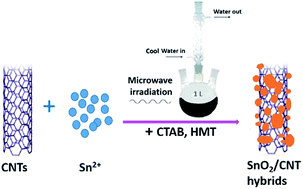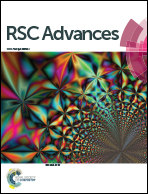Microwave-assisted and large-scale synthesis of SnO2/carbon-nanotube hybrids with high lithium storage capacity
Abstract
A novel SnO2/carbon-nanotube hybrid has been successfully synthesized at large scale by an ultrafast and environmentally benign microwave-assisted technique under atmospheric condition. The as-synthesized hybrids feature a unique structure with ultrathin SnO2 nanosheets and nanoparticles composited on multiwalled carbon nanotubes (CNTs). The specific surface area of the hybrids is as high as 145.46 m2 g−1 even with high SnO2 loading percentage of ∼85 wt%. The SnO2/carbon-nanotube hybrids used as anode material for LIB exhibit an ultrahigh initial capacity of 3247.5 mA h g−1 with a large reversible capacity of 1616.5 mA h g−1 at 200 mA g−1. After 80 repeated discharge and charge cycles, a reversible capacity of 710.4 mA h g−1 is maintained. As Compared to pure SnO2 nanosheets, the SnO2/carbon-nanotube hybrids exhibit enhanced electrochemical lithium ion storage, which could be ascribed to the unique architecture with more active sites and favorable channel for Li+ insertion/extraction. Hence, this microwave-assisted method demonstrates a high-efficiency and timesaving way to synthesize advanced SnO2-based anode materials for promising scalable commercialization.


 Please wait while we load your content...
Please wait while we load your content...